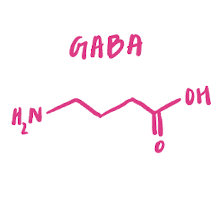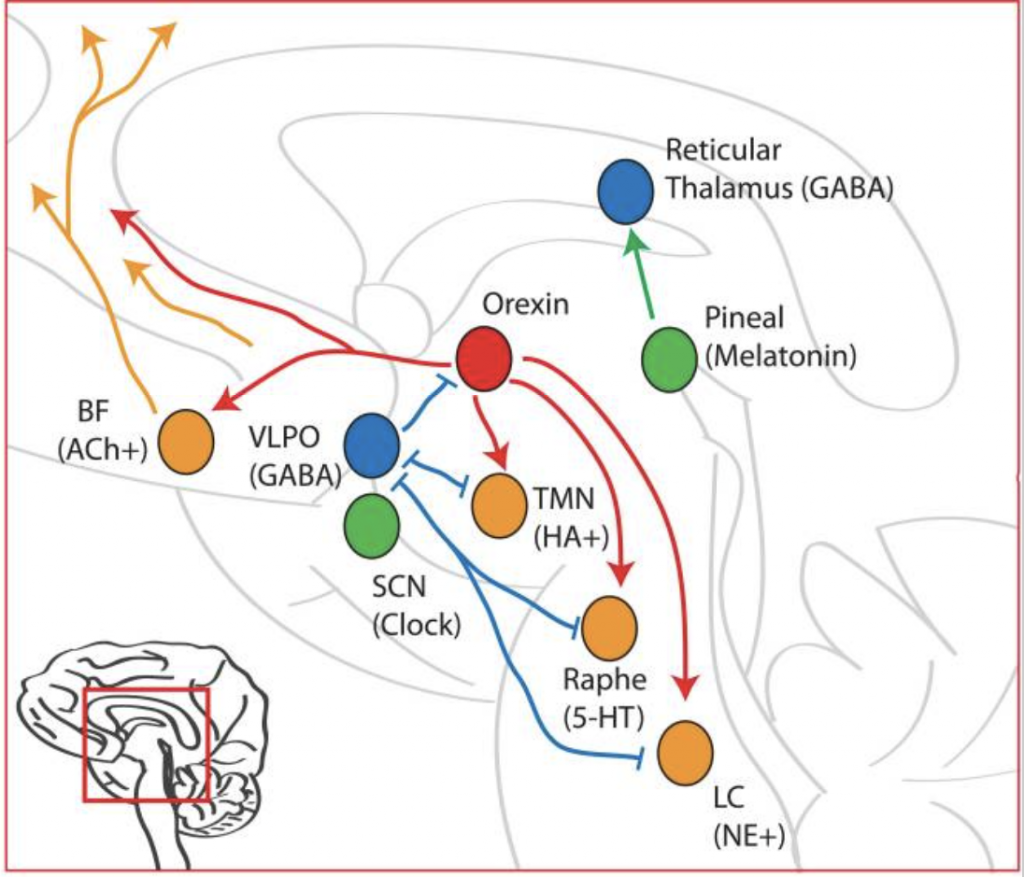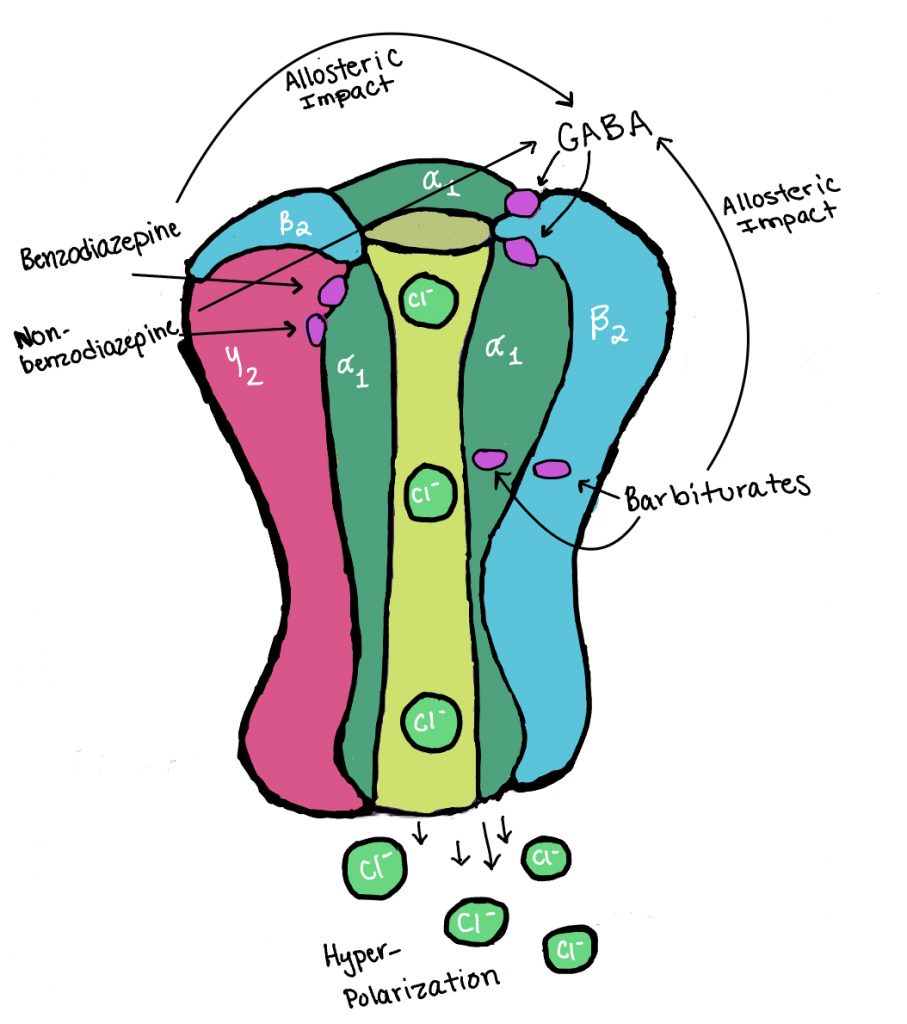
Most drugs currently used to treat insomnia increase γ-aminobutyric acid (GABA) activity by targeting GABAergic neurons (neurons that produce GABA) or GABA receptors (receptors that use GABA as a ligand), including benzodiazepines such as flurazepam and non-barbiturates such as zolpidem.
Historically, barbiturates have also been used extensively although the use of barbiturates has declined and other drugs with less side effects are used today. Barbiturates, a central nervous system depressant, are commonly used as anxiolytics and anticonvulsants, causing users to feel relaxed and drowsy. All of these drugs have sedating effects and target GABA function in some way, which hints at the role of GABA in insomnia.
GABA is the main inhibitory neurotransmitter in the central nervous system (CNS), and it is known to have a major role in sleep-wake cycles. According to the “flip-flop” model of the sleep-wake cycle, sleep and wake states are governed by antagonistic wake-promoting and sleep-promoting neurons. GABA release from the ventrolateral preoptic area (VLPO) of the brain is thought to inhibit wake-promoting centers in the histaminergic tuberomammillary nucleus (TMN), the noradrenergic locus coeruleus (LC), and the serotonergic neurons of the dorsal raphe (6) (Fig. 2). In addition, a study using Drosophila as a model organism showed that when GABA receptors were modified to remain open longer, sleep latency (time taken to fall asleep) decreased while treatment with carbamazepine, which enhances channel desensitization and closure, increased sleep latency (6, 7). Although some studies have produced contradictory results, the majority of studies which used proton magnetic resonance spectroscopy (1H-MRS) to study GABA levels in the brain found lower levels of GABA in various regions of the brain in individuals with primary insomnia (PI) (4). Thus, a large body of evidence points towards GABA’s role as a major neurotransmitter involved in the regulation of sleep.

Unfortunately, the exact role of GABA in sleep and insomnia is still not yet well understood in humans. However, the current body of research and the efficacy of GABA-targeting drugs strongly suggests that dysregulation and lowered activity of GABA pathways contributes to insomnia, and many current drug treatments work by increasing GABA activity. Benzodiazepines (BZD) act as GABA receptor agonists and bind to GABA-A receptors (there are also B and C receptors) (see GABA-A receptor page). GABA-A receptors are composed of 5 glycoprotein subunits which each have various isoforms (2 α subunits, 2 β subunits, and 1 γ subunit). Each GABA-A receptor complex also has 2 GABA-binding sites and one 1 BZD-binding site located at the intersection of the α and γ subunits (8). Although still not yet fully understood, it is thought that once BZD binds, a conformational change in the GABA-A receptor increases the binding affinity of GABA to the receptor, which increases the time that the GABA-A receptor’s chloride channel remains open. Alternatively, binding of BZDs to the receptor shifts the GABA-A receptor closed to open-state channel equilibrium in order to positively modulate chloride current. This leads to increased hyperpolarization of the cell and an increased inhibitory effect by GABA (8, 9).

Other new generation non-benzodiazepines (NBZDs) also increase GABA activity by binding to GABA-A receptors at the BZD-binding site. While some NBZDs such as zopiclone and eszopiclone bind nonspecifically to all GABA-A receptors like traditional benzodiazepines, other NBZDs have specific affinity for GABA-A receptors with an α1 isoform subunit (10). The mechanism behind barbiturates is not fully understood, but they are thought to similarly target the GABA-A receptor to increase chloride ion flux. In addition, barbiturates in high dosages can even increase chloride ion flux at low concentrations of GABA (11).
Overall, I think this section did a good job on emphasizing the possible role GABA has with sleep/insomnia. Moreover, I think the explanation of mechanism view is concise. However, some parts of the section lack of background information and directly dive into particular term. For instance, at the beginning of paragraph 2, I do not know what “barbiturates” is, neither do I know what “carbamazepine” is and how its treatment decrease sleep latency. In addition, the word already mentioned benzodiazepines in question and earlier section of answer. I do not know why it was abbreviated until paragraph 4 of this section.
I agree with Jinpeng here, I think some background on these terms could be useful. It seems like this section relies somewhat on understanding these drugs and their use in the past so it might be key to go more in depth on them. Otherwise, I think this section looks great. The mentioning of Drosophila as a model organism was also useful in understanding how GABA receptors relate to sleep latency.
Added a sentence about the general function of barbiturates!
I like how your figures clearly display the different subunits of receptors and their interactions. very informative and descriptive. Nicely done.
I think that having a figure or some imagery displaying how a hyperpolarization looks on an electrical level is useful as it is often difficult to visualize if you are not familiar.
There is also alot of technical jargon (not that its bad) but it can make reading through this a bit confusing for the average person who is not scientifically literate or knowledgable in cell biology. Wrapping up the text in a clear and concise overview at the end or beginning could also be useful.
I like how detailed this page is with the explanations, especially the fruit fly GABA experiment. The diagram in the figure made the pathway clearer. This page definitely helped me understand the importance of GABA in sleep regulation.
A couple suggestions I have:
1) Define barbiturates, give examples, why they’re bad, and/or what they do.
2) The format of the in-text references to the figures should be consistent with the other pages. So probably un-bold and use the entire word for figure (i.e., figure # or Figure #)
3) I’m not sure if this is possible, but the figure description of figure 2 was overwhelming to read. A sub-tab may help with this it is too much to fit on this page.
4) The section about GABA receptors and the structure details might deserve its own paragraph.
5) What is hyperpolarization of the cell? If it’s important, a figure here or a couple sentences could help explain why it leads to an increased inhibitory effect.
6) I like figure 3 and how its description shows where things bind. I do think it may be better to have this cited in-text (and incorporated) in the section about receptor structure.
I think overall this page does a great job of providing a thorough explanation of how GABA may be involved in sleep, with excellent research paper selection. The two main criticisms I have for this page are organization and flow. In order to combat these problems, I think the paragraph which explains what GABA is and its role in sleep(paragraph 3) can be broken into two paragraphs, one which gives a general overview of GABA function and one specific to sleep. I also think introducing GABA’s over all function could be either the first or second paragraph to increase flow. Additionally, as Rob mentioned, there is a significant amount of technical terms in this section, and I think some summarizing would greatly benefit this page.
Edited the caption for figure 2 for conciseness and clarity!
I agree about the comments regarding defining barbiturates. I have included a small sentence regarding the primary role of barbiturates. Generally speaking, for primary use benzodiazepines are more commonly used in today’s society.